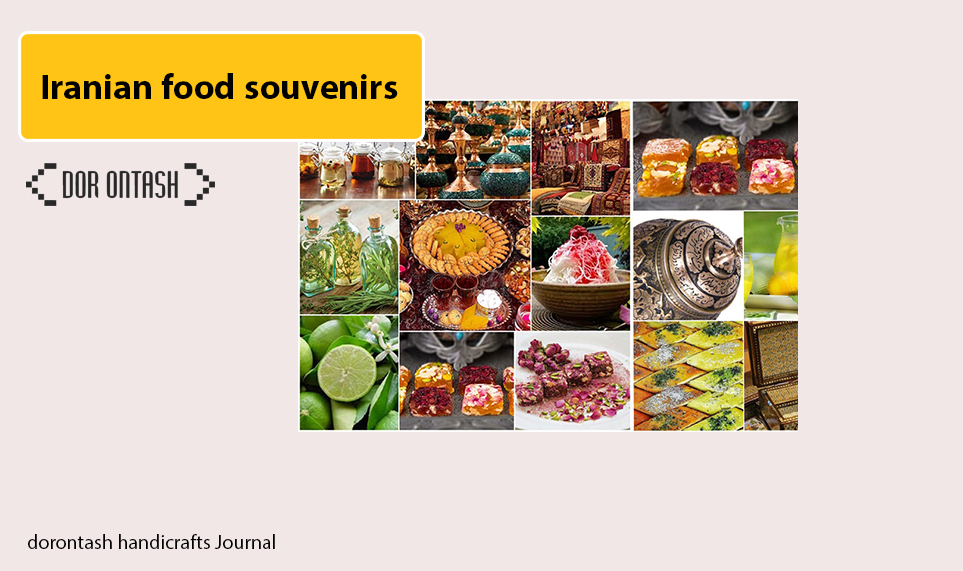Iran’s culture and art are tied to handicrafts, and a large part of our country’s tourism is intertwined with it. the selected handicrafts of iran that have passed the borders of Iran for centuries and gained world fame. Take from Iran’s carpet, which is famous in the world, to the fine woven fabrics of the Sassanid era, of which there is no trace left today. Handicrafts, which are a part of Iran’s identity, and have a great potential for tourism in our country. Due to this importance, in this article we went to the most important types of handicrafts in Iran and tried to briefly introduce some of the best and most famous handicrafts of the country. Handicrafts, some of which are so valuable that they have entered the UNESCO World Heritage List and are now part of the world heritage of mankind
Mat weaving | the selected handicrafts of iran
The first handicraft of Iran that we will discuss today is mat weaving. Today, mat weaving in Iran is mostly used as home decoration. This art, which is one of the oldest handicrafts in the world, is created by weaving strands of plant fibers together. If we follow the traces of antiquity and the limited works discovered in Africa and Mesopotamia, we find that in the past these people made mats by weaving swamp plants together. At present, 16 countries have mat weaving as this industry in their history, among the most famous countries are Japan, Korea and Mexico.
Mat weaving is an industry that is still considered one of the most popular handicrafts in Iran. These mats are made in different shapes and sizes. The raw materials of mat weaving are different in different cities and countries. Choosing the right wood for making mats is done according to the weather of different climates. The way the mat is woven is also different depending on the climate. But all mats are made of taropod.
Iranian carpet | the selected handicrafts of iran
Iranian carpet or Iranian carpet is the most famous and important handicraft of Iran, which dates back to the Achaemenid period. Iranian hand-woven carpets have long been famous, and nowadays they are bought and sold at the global level. Carpet plays a very important role in the culture and art of Iran, and its exquisite examples have become a piece of art that can be displayed in museums, or in the form of carpets, a spectacular effect for houses and mansions. they forgive
Most Iranian carpets are usually made of wool; But the best and most expensive types of carpets are those that have a silk texture. Iranian carpets are woven in a variety of designs and colors, the most famous of which are Shah Abbasi design, Slimi design, Bete Jaqeh design, tree design, Ili and Nomadic design, and geometric design.
The second handiwork of Iran, which is very valuable and makes your eyes stare, is cashmere cloth. Cashmere is one of the exquisite Iranian fabrics, which we all know with the Bete Jaqe pattern. The fibers of this fabric are very soft and consist of various raw materials such as fluff and wool or silk, and are produced in a variety of colors, designs and patterns. Behind the cashmere fabric, the weft is loose and dense; But it looks completely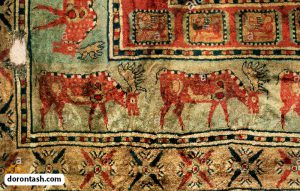 smooth and uniform on the fabric.
smooth and uniform on the fabric.
miniature | the selected handicrafts of iran
Painting, or what has become popular among people as miniatures, is the art of painting, patterning, and portraiture, and it is one of the most important arts that was popular in ancient Iran, and it is rarely drawn these days.
Illustrated book pages are very expensive and are sold as a luxury Iranian handicraft. Iranian painting can be performed both on paper and in the form of scientific, literary, and medical books, and it can be displayed in larger dimensions on screen, canvas, tapestry, and wall.
Kamaluddin Behzad is the most famous Iranian painter and Master Farshchan is known as the most famous living Iranian painter these days.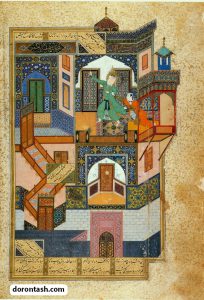
copper dishes
The first metal that humans could discover was copper. History shows that humans used copper a lot. They melted the copper metal, then shaped it and made various tools such as knives, etc. Of course, after the expansion of the use of copper, in addition to the main tools such as knives, decorative items such as pendants were also made.
Copper dishes are one of the oldest tools for cooking and catering, which have a long life, are resistant to heat and have a very beautiful color. Copper dishes are one of the most common handicrafts in Iran.
In which cities of Iran can the best copper vessels be found?
The use of copper dates back to 9,500 years BC, and in our country, copper and coppersmithing have a long history in Zanjan province. The use of copper containers has been revived after almost two decades of using plastic containers and materials, and these containers have entered the market with different decorations. Zanjan province is one of the most active provinces in the production of copper products and containers. After that, Tehran and Isfahan have the highest number of copper vessels as handicrafts of Iran.
pottery | the selected handicrafts of iran
In the next step, we go to the ancient art of pottery. Pottery has been associated with Iranian people for a long time and is still known as a valuable handicraft among Iranians and foreign tourists.
Pottery, as you know, is the art of making containers with mud, and this type of handicraft in Iran is more than 10,000 years old. Susa hosts the oldest pottery wheel and pottery kiln in the world, and the world’s oldest engraved pottery vessels have also been found in Iran.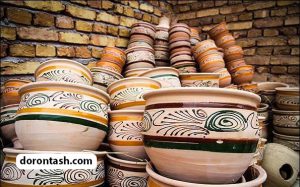
Enamels
Minakari or Minagri is one of the most important types of handicrafts in Iran with a history of 5,000,000 years. Enameling is placed in the group of metal handicrafts and can be performed on metals such as copper, gold and silver. Most of us know enameling as azure blue, but enameled dishes in gold, green, yellow, black and pink can also be seen in the market. Isfahan is the heart of enameling in the world and the best examples of enameling are made in this city. 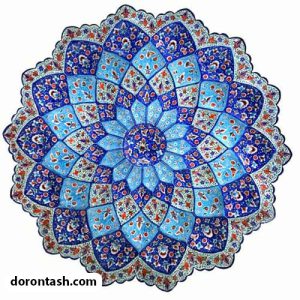
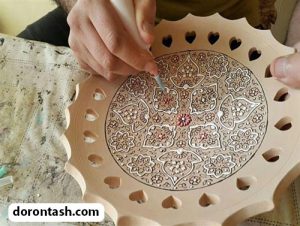
Khatam Kari
Khatamkari is a type of wooden handicraft and its production is popular in Isfahan, Shiraz and Tehran. To make a seal, regular polygons of different materials are put together to finally reach the final shape they want. Khatam is sold in various colors and various raw materials with different colors are used in its construction. Making a seal takes a lot of time from the seal artist and requires a lot of precision. Wooden materials such as walnut, juniper, ebony and various types of bone such as elephant ivory, camel bone and horse bone are usually used in making Khatam.
If you are going on a trip to Shiraz and would like to visit the world of souvenirs and handicrafts of this city before your trip, we recommend you to read the introduction of souvenirs and handicrafts of Shiraz Homsa.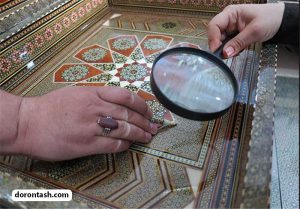
inlaid work
Everything that is decorated with jewels is called inlay, and the art of inlaying means placing jewels on dishes, ornaments and decorative objects. They also refer to inlaying with the names of jewelry making, gem making or makhrajkari. Inlay work is one of the branches of various stone handicrafts and is several thousand years old in Iran. The stones that are mostly used in inlay work are jagari agate, turquoise, diamond, ruby and jade.
penman cloth
Qalamkar fabric is a type of patterned fabric that is prepared by the art of printing or making a pattern on the fabric. They also mention penmanship with the name of chitsazi. This fabric can be used as a tablecloth, bedspread, rug, tablecloth, quilt cover, back cover, handkerchief, scarf, etc. Isfahan is the cradle of calligraphy in Iran and the best examples of calligraphy fabrics can be found in this city.
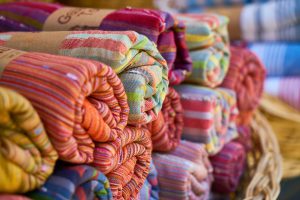
Towels
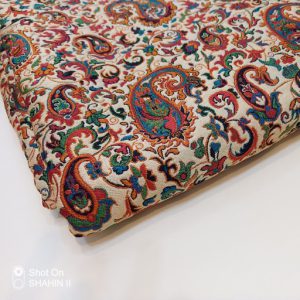 Water crafts
Water crafts
Abgineh is another handicraft of Iran and it is called the art of decorating glass used in various appliances. This art is developed on the basis of broken glass and shards of glass and in cities such as Tehran, Isfahan, Maimand, Qomsar, etc., it is of interest to artists and craftsmen.
wooden handicrafts
Wooden handicrafts are one of the most popular Iran handicrafts. In most cases, the decoration of wooden works is done after the construction of the body. In this way, first the main body of the object is made with various carpentry and joinery methods, then the decoration work is carried out in different ways on their surface or they are glued in the form of a ready layer.
cashew
Cashmere is one of the most exquisite Iranian fabrics, and many foreign tourists take a sample of it as a souvenir when they travel to Iran. This fabric, the best type of which is produced in Yazd, has very soft fibers and is sold in various colors. The best type of cashmere is woven in Yazd and its raw materials include fluff, wool or silk. Cashmere has a completely smooth and uniform surface and its most famous design is the bete jakeh.
Embroidered leather
Leather embroidery or traditional embroidery is the art of sewing and embroidering leather products with the help of hands and simple tools. The most important Iranian embroidered leather products are bags and shoes, which are produced in some cities of Iran with very high quality. The cities of Hamedan, Tabriz, Mashhad and Isfahan were famous for Saraji since ancient times, and anyone who was engaged in leather embroidery in these cities was known by the name of Saraji family.
felt
Felt and the art of felting is a type of traditional weaving that is produced with wool. Felt is actually a kind of underlay. The interesting thing is that the felt is not woven like a carpet, the way it is produced by creating pressure, humidity and heat causes the wool fibers to get tangled and the felt is formed. The material of felt is sheep’s wool, and this is the property of wool that they can make felt from. The production of a piece of felt usually takes one day, and the felters often work in pairs. Among the types of Iranian handicrafts and felt products, we can mention rugs, felt hats, and felt coats.


